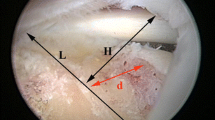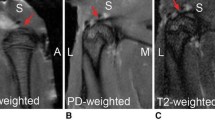Abstract
Purpose
While the use of bone marrow concentrate (BMC) has been described in the treatment of rotator cuff tears, the impact of a rotator cuff injury on the mesenchymal stem cells (MSCs) content present in the human shoulder has not been determined, especially with regard to changes in the levels of MSCs at the tendon–bone interface. With the hypothesis that there was a decreased level of MSCs at the tendon–bone interface tuberosity in patients with rotator cuff tear, we assessed the level of MSCs in the tuberosity of the shoulder of patients undergoing a rotator cuff repair.
Methods
We analysed the data of 125 patients with symptomatic rotator cuff tears and of 75 control patients without rotator cuff injury. We recorded the following data: size of tear, number of torn tendons, aetiology of the tear, lag time between onset of shoulder symptoms/injury and repair, and also fatty infiltration of muscles. Mesenchymal stem cell content at the tendon–bone interface tuberosity was evaluated by bone marrow aspiration collected in the humeral tuberosities of patients at the beginning of surgery.
Results
A significant reduction in MSC content (from moderate, 30–50 %, to severe >70 %) at the tendon–bone interface tuberosity relative to the MSC content of the control was observed in all rotator cuff repair study patients. Severity of the decrease was statistically correlated to a number of factors, including the delay between onset of symptoms and surgery, number of involved tendons, fatty infiltration stage and increasing patient age.
Conclusion
This study demonstrates that the level of MSCs present in the greater tuberosity of patients with a rotator cuff tear decreases as a function of a number of clinical factors, including lag time from tear onset to treatment, tear size, number of tears and stage of fatty infiltration, among others. This information may help the practices in using biologic augmentation of a rotator cuff repair.
Similar content being viewed by others
References
Awad HA, Butler DL, Boivin GP, Smith FN, Malaviya P, Huibregtse B et al (1999) Autologous mesenchymal stem cell-mediated repair of tendon. Tissue Eng 5:267–77
Barber FA, Hrnack SA, Snyder SJ, Hapa O (2011) Rotator cuff repair healing influenced by platelet-rich plasma construct augmentation. Arthroscopy 27:1029–35
Bigliani LU, Cordasco FA, McIlveen SJ, Musso ES (1992) Operative treatment of failed repairs of the rotator cuff. J Bone Joint Surg Am 74:1505–1515
Boileau P, Brassart N, Watkinson DJ, Carles M, Hatzidakis AM, Krishnan SG (2005) Arthroscopic repair of full-thickness tears of the supraspinatus: does the tendon really heal? J Bone Joint Surg Am 87:1229–1240
Chang CH, Chen C, Su C, Liu H, Yu C (2009) Rotator cuff repair with periosteum for enhancing tendon–bone healing: a biomechanical and histological study in rabbits. Knee Surg Sports Traumatol Arthrosc 17:1447–1453
Chen JM, Willers C, Xu J, Wang A, Zheng MH (2007) Autologous tenocyte therapy using porcine-derived bioscaffolds for massive rotator cuff defect in rabbits. Tissue Eng 13:1479–91
Dines JS, Grande DA, Dines DM (2007) Tissue engineering and rotator cuff tendon healing. J Shoulder Elb Surg 16(5):S204–S207
Ellera Gomes JL, da Silva RC, Silla LM, Abreu MR, Pellanda R (2011) Conventional rotator cuff repair complemented by the aid of mononuclear autologous stem cells. Knee Surg Sports Traumatol Arthrosc 1607–9
Fuchs B, Weishaupt D, Zanetti M, Hodler J, Gerber C (1999) Fatty degeneration of the muscles of the rotator cuff: assessment by computed tomography versus magnetic resonance imaging. J Shoulder Elb Surg 8:599–605
Funakoshi T, Majima T, Iwasaki N, Suenaga N, Sawaguchi N, Shimode K et al (2005) Application of tissue engineering techniques for rotator cuff regeneration using a chitosan-based hyaluronan hybrid fiber scaffold. Am J Sports Med 33:1193–201
Galatz LM, Ball CM, Teefey SA, Middleton WD, Yamaguchi K (2004) The outcome and repair integrity of completely arthroscopically repaired large and massive rotator cuff tears. J Bone Joint Surg Am 86-A:219–224
Goutallier D, Postel JM, Lavau L, Voisin MC (1994) Fatty muscle degeneration in cuff ruptures. Pre and postoperative evaluation by CT scan. Clin Orthop Relat Res 304:78–83
Gulotta LV, Kovacevic D, Ehteshami JR, Dagher E, Packer JD, Rodeo SA (2009) Application of bone marrow-derived mesenchymal stem cells in a rotator cuff repair model. Am J Sports Med 37:2126–2133
Harryman DT II, Mack LA, Wang KY, Jackins SE, Richardson ML, Masten FA (1991) Repairs of the rotator cuff. Correlation of functional results with integrity of the cuff. J Bone Joint Surg Am 73:982–989
Hernigou P, Flouzat-Lachaniette CH, Delambre J, Poignard A, Allain J, Chevallier N, Rouard H (2015) Osteonecrosis repair with bone marrow cell therapies: state of the clinical art. Bone 70:102–9
Hernigou P, Flouzat Lachaniette CH, Delambre J, Zilber S, Duffiet P, Chevallier N, Rouard H (2014) Biologic augmentation of rotator cuff repair with mesenchymal stem cells during arthroscopy improves healing and prevents further tears: a case-controlled study. Int Orthop 38(9):1811–8
Hernigou P, Homma Y, Flouzat-Lachaniette CH, Poignard A, Chevallier N, Rouard H (2013) Cancer risk is not increased in patients treated for orthopaedic diseases with autologous bone marrow cell concentrate. J Bone Joint Surg Am 95(24):2215–21
Hernigou P, Poignard A, Beaujean F, Rouard H (2005) Percutaneous autologous bone-marrow grafting for nonunions. Influence of the number and concentration of progenitor cells. J Bone Joint Surg Am 87:1430–7
Isaac C, Gharaibeh B, Witt M, Wright VJ, Huard J (2012) Biologic approaches to enhance rotator cuff healing after injury. J Shoulder Elb Surg 21:181–190
Jost B, Zumstein M, Pfirrmann C, Gerber C (2006) Long-term outcome after structural failure of rotator cuff repairs. J Bone Joint Surg Am 88:472–479
Kobayashi M, Itoi E, Minagawa H, Miyakoshi N, Takahashi S, Tuoheti Y et al (2006) Expression of growth factors in the early phase of supraspinatus tendon healing in rabbits. J Shoulder Elb Surg 15:371–7
Kovacevic D, Rodeo S (2008) Biological augmentation of rotator cuff tendon repair. Clin Orthop Relat Res 466:622–633
Liem D, Lichtenberg S, Magosch P, Habermeyer P (2007) Magnetic resonance imaging of arthroscopic supraspinatus tendon repair. J Bone Joint Surg Am 89:1770–1776
Maijenburg MW, Kleijer M, Vermeul K, Mul EP, van Alphen FP, van der Schoot CE, Voermans C (2012) The composition of the mesenchymal stromal cell compartment in human bone marrow changes during development and aging. Haematologica 97(2):179–83
Mazzocca AD, McCarthy MB, Chowaniec DM, Cote MP, Arciero RA, Drissi H (2010) Rapid isolation of human stem cells (connective tissue progenitor cells) from the proximal humerus during arthroscopic rotator cuff surgery. Am J Sports Med 38(7):1438–47
Mazzocca AD, McCarthy MB, Chowaniec D, Cote MP, Judson CH, Apostolakos J, Solovyova O, Beitzel K, Arciero RA (2011) Bone marrow-derived mesenchymal stem cells obtained during arthroscopic rotator cuff repair surgery show potential for tendon cell differentiation after treatment with insulin. Arthroscopy 27(11):1459–71
Mellado JM, Calmet J, Olona M, Esteve C, Camins A, Perez Del Palomar L, Gine J, Sauri A (2005) Surgically repaired massive rotator cuff tears: MRI of tendon integrity, muscle fatty degeneration, and muscle atrophy correlated with intraoperative and clinical findings. Am J Roentgenol 184:1456–1463
Murphy MB, Moncivais K, Caplan AI (2013) Mesenchymal stem cells: environmentally responsive therapeutics for regenerative medicine. Exp Mol Med 45:e54. doi:10.1038/emm.2013.94
Nakagaki K, Ozaki J, Tomita Y, Tamai S (1994) Alterations in the supraspinatus muscle belly with rotator cuff tearing: Evaluation with magnetic resonance imaging. J Shoulder Elb Surg 3:88–93
Rodeo SA, Potter HG, Kawamura S, Turner AS, Kim HJ, Atkinson BL (2007) Biologic augmentation of rotator cuff tendon healing with use of a mixture of osteoinductive growth factors. J Bone Joint Surg Am 89:2485–2497
Seeherman HJ, Archambault JM, Rodeo SA, Turner AS, Zekas L, D’Augusta D et al (2008) rhBMP-12 accelerates healing of rotator cuff repairs in a sheep model. J Bone Joint Surg Am 90:2206–19
Seeherman HJ, Archambault JM, Rodeo SA, Turner AS, D’Augusta D, Li XJ, Smith E, Wozney JM (2008) rhBMP-12 accelerates healing of rotator cuff repairs in a sheep model. J Bone Joint Surg Am 90:2206–2219
Yamaguchi K, Ditsios K, Middleton WD, Hildebolt CF, Galatz LM, Teefey SA (2006) The demographic and morphological features of rotator cuff disease. A comparison of asymptomatic and symptomatic shoulders. J Bone Joint Surg Am 88:1699–1704
Acknowledgments
We thank Ted Sand and Richard Suzuki and the other members of Celling Biosciences for the review of the final manuscript, and their help in translation.
Author information
Authors and Affiliations
Corresponding author
Rights and permissions
About this article
Cite this article
Hernigou, P., Merouse, G., Duffiet, P. et al. Reduced levels of mesenchymal stem cells at the tendon–bone interface tuberosity in patients with symptomatic rotator cuff tear. International Orthopaedics (SICOT) 39, 1219–1225 (2015). https://doi.org/10.1007/s00264-015-2724-8
Received:
Accepted:
Published:
Issue Date:
DOI: https://doi.org/10.1007/s00264-015-2724-8




